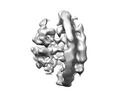+ Open data
Open data
- Basic information
Basic information
| Entry |  | |||||||||
|---|---|---|---|---|---|---|---|---|---|---|
| Title | Subtomogram averaging of ciliary beads from ciliary membrane | |||||||||
 Map data Map data | Subtomogram averaging of ciliary beads from ciliary membrane | |||||||||
 Sample Sample |
| |||||||||
 Keywords Keywords | Inhibitor / SIGNALING PROTEIN | |||||||||
| Biological species |  | |||||||||
| Method | subtomogram averaging / cryo EM / Resolution: 55.0 Å | |||||||||
 Authors Authors | Zhang Z / Moye A / He F / Chen M / Agosto AA / Wensel TG | |||||||||
| Funding support |  United States, 1 items United States, 1 items
| |||||||||
 Citation Citation |  Journal: Life Sci Alliance / Year: 2024 Journal: Life Sci Alliance / Year: 2024Title: Centriole and transition zone structures in photoreceptor cilia revealed by cryo-electron tomography. Authors: Zhixian Zhang / Abigail R Moye / Feng He / Muyuan Chen / Melina A Agosto / Theodore G Wensel /    Abstract: Primary cilia mediate sensory signaling in multiple organisms and cell types but have structures adapted for specific roles. Structural defects in them lead to devastating diseases known as ...Primary cilia mediate sensory signaling in multiple organisms and cell types but have structures adapted for specific roles. Structural defects in them lead to devastating diseases known as ciliopathies in humans. Key to their functions are structures at their base: the basal body, the transition zone, the "Y-shaped links," and the "ciliary necklace." We have used cryo-electron tomography with subtomogram averaging and conventional transmission electron microscopy to elucidate the structures associated with the basal region of the "connecting cilia" of rod outer segments in mouse retina. The longitudinal variations in microtubule (MT) structures and the lumenal scaffold complexes connecting them have been determined, as well as membrane-associated transition zone structures: Y-shaped links connecting MT to the membrane, and ciliary beads connected to them that protrude from the cell surface and form a necklace-like structure. These results represent a clearer structural scaffold onto which molecules identified by genetics, proteomics, and superresolution fluorescence can be placed in our emerging model of photoreceptor sensory cilia. | |||||||||
| History |
|
- Structure visualization
Structure visualization
| Supplemental images |
|---|
- Downloads & links
Downloads & links
-EMDB archive
| Map data |  emd_41814.map.gz emd_41814.map.gz | 7.4 MB |  EMDB map data format EMDB map data format | |
|---|---|---|---|---|
| Header (meta data) |  emd-41814-v30.xml emd-41814-v30.xml emd-41814.xml emd-41814.xml | 12 KB 12 KB | Display Display |  EMDB header EMDB header |
| Images |  emd_41814.png emd_41814.png | 43.7 KB | ||
| Filedesc metadata |  emd-41814.cif.gz emd-41814.cif.gz | 4 KB | ||
| Others |  emd_41814_half_map_1.map.gz emd_41814_half_map_1.map.gz emd_41814_half_map_2.map.gz emd_41814_half_map_2.map.gz | 8.7 MB 8.8 MB | ||
| Archive directory |  http://ftp.pdbj.org/pub/emdb/structures/EMD-41814 http://ftp.pdbj.org/pub/emdb/structures/EMD-41814 ftp://ftp.pdbj.org/pub/emdb/structures/EMD-41814 ftp://ftp.pdbj.org/pub/emdb/structures/EMD-41814 | HTTPS FTP |
-Validation report
| Summary document |  emd_41814_validation.pdf.gz emd_41814_validation.pdf.gz | 607.7 KB | Display |  EMDB validaton report EMDB validaton report |
|---|---|---|---|---|
| Full document |  emd_41814_full_validation.pdf.gz emd_41814_full_validation.pdf.gz | 607.3 KB | Display | |
| Data in XML |  emd_41814_validation.xml.gz emd_41814_validation.xml.gz | 9.6 KB | Display | |
| Data in CIF |  emd_41814_validation.cif.gz emd_41814_validation.cif.gz | 11.3 KB | Display | |
| Arichive directory |  https://ftp.pdbj.org/pub/emdb/validation_reports/EMD-41814 https://ftp.pdbj.org/pub/emdb/validation_reports/EMD-41814 ftp://ftp.pdbj.org/pub/emdb/validation_reports/EMD-41814 ftp://ftp.pdbj.org/pub/emdb/validation_reports/EMD-41814 | HTTPS FTP |
-Related structure data
- Links
Links
| EMDB pages |  EMDB (EBI/PDBe) / EMDB (EBI/PDBe) /  EMDataResource EMDataResource |
|---|
- Map
Map
| File |  Download / File: emd_41814.map.gz / Format: CCP4 / Size: 12.4 MB / Type: IMAGE STORED AS FLOATING POINT NUMBER (4 BYTES) Download / File: emd_41814.map.gz / Format: CCP4 / Size: 12.4 MB / Type: IMAGE STORED AS FLOATING POINT NUMBER (4 BYTES) | ||||||||||||||||||||
|---|---|---|---|---|---|---|---|---|---|---|---|---|---|---|---|---|---|---|---|---|---|
| Annotation | Subtomogram averaging of ciliary beads from ciliary membrane | ||||||||||||||||||||
| Voxel size | X=Y=Z: 4.45 Å | ||||||||||||||||||||
| Density |
| ||||||||||||||||||||
| Symmetry | Space group: 1 | ||||||||||||||||||||
| Details | EMDB XML:
|
-Supplemental data
-Half map: Masked even half map
| File | emd_41814_half_map_1.map | ||||||||||||
|---|---|---|---|---|---|---|---|---|---|---|---|---|---|
| Annotation | Masked even half map | ||||||||||||
| Projections & Slices |
| ||||||||||||
| Density Histograms |
-Half map: Masked odd map
| File | emd_41814_half_map_2.map | ||||||||||||
|---|---|---|---|---|---|---|---|---|---|---|---|---|---|
| Annotation | Masked odd map | ||||||||||||
| Projections & Slices |
| ||||||||||||
| Density Histograms |
- Sample components
Sample components
-Entire : ROS(rod of outer segments)of mouse photoreceptor
| Entire | Name: ROS(rod of outer segments)of mouse photoreceptor |
|---|---|
| Components |
|
-Supramolecule #1: ROS(rod of outer segments)of mouse photoreceptor
| Supramolecule | Name: ROS(rod of outer segments)of mouse photoreceptor / type: organelle_or_cellular_component / ID: 1 / Parent: 0 |
|---|---|
| Source (natural) | Organism:  |
-Experimental details
-Structure determination
| Method | cryo EM |
|---|---|
 Processing Processing | subtomogram averaging |
| Aggregation state | cell |
- Sample preparation
Sample preparation
| Buffer | pH: 7.5 |
|---|---|
| Vitrification | Cryogen name: ETHANE |
- Electron microscopy
Electron microscopy
| Microscope | FEI POLARA 300 |
|---|---|
| Image recording | Film or detector model: DIRECT ELECTRON DE-12 (4k x 3k) / Average exposure time: 1.0 sec. / Average electron dose: 10.0 e/Å2 |
| Electron beam | Acceleration voltage: 300 kV / Electron source:  FIELD EMISSION GUN FIELD EMISSION GUN |
| Electron optics | Illumination mode: FLOOD BEAM / Imaging mode: BRIGHT FIELD / Nominal defocus max: 1.2 µm / Nominal defocus min: 0.8 µm |
| Experimental equipment |  Model: Tecnai Polara / Image courtesy: FEI Company |
- Image processing
Image processing
| Final reconstruction | Resolution.type: BY AUTHOR / Resolution: 55.0 Å / Resolution method: FSC 0.143 CUT-OFF / Number subtomograms used: 400 |
|---|---|
| Extraction | Number tomograms: 1 / Number images used: 500 |
| Final angle assignment | Type: PROJECTION MATCHING |
 Movie
Movie Controller
Controller






 Z
Z Y
Y X
X

















